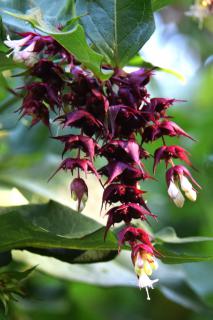

Himalayan honeysuckle is a shrub with fantastic flowers.
Himalayan honeysuckle facts
Name: Leycesteria formosa
Family: Caprifoliaceae (honeysuckle)
Type: shrub
Height: 6 ½ feet (2 meters)
Exposure: full sun, part sun
Soil: ordinary, well drained – Foliage: deciduous – Flowering: summer, mid-fall
Proper planting, pruning and care ensure the proper development of the Himalayan honeysuckle.
Indifferently, in fall or spring.
Multiply through crown division in fall or through cuttings in spring.

Reduce and balance out the branches at the end of winter or at the very beginning of spring to promote flowering.
Leycesteria is resistant to most diseases and thus shouldn’t cause you any issues from that point of view.
As for watering, it is important to water regularly during the first 2 years after planting.
Afterwards, the shrub is able to find water on its own.

Himalayan honeysuckle is an elegant upright and bushy plant that produces cute drooping and colorful bunches of flowers.
These flowers replenish themselves over and over during summer and will decorate your garden until the month of September.
Its deciduous leafage is a tender green color whereas its stems stay green all year long.
After flowering, cute purple berries appear which are said to taste of caramel and be highly attractive to birds like pheasants.
Set this shrub up as a hedge when preparing a flowered hedge or simply in a shrub bed, small copse or as a standalone.
If you plant during winter, avoid frost and freezing because that might make regrowth in spring impossible.